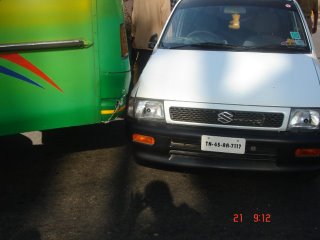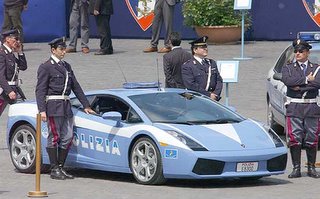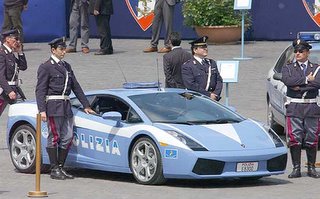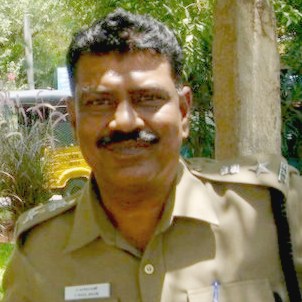Friday, March 24, 2006
Karthick- the Indian ace driver
Today i went to fuel my car and I was very happy.... They told me that Karthick, India's no:! driver fuels at the same outlet. Very exciting isn't it? Must be for my nephew Arul,who is very crazy about Karthick Narain.
Wednesday, March 15, 2006
Project presentation
Respected Guest of Honour, chairman, and dear Students of PSG Arts and science college
It gives me great pleasure to come here and I thank the department of corporate secretaryship for having given me this chance to stand before this young generation.
I went through the project report and I am greatly delighted at your sincere effort to analyze the cause of accidents that take place at Coimbatore. I do not want to frighten you with facts and figures. I do agree the buses and as a whole, the heavy vehicles play a great part in causing these accidents. These sorts of projects help the police to take more actions against the lawbreakers. I congratulate you on this sincere effort.
Next to Chennai city, Coimbatore registers the highest number of vehicles. An average of about 300 vehicles is registered per day in the two R.T.O offices. We take lots of measures to make the day an accident free day. You will all agree that “a life is precious”. We don’t want anyone to be maimed.
Your study reveals that more people are aware of the causes that cause accidents. Though they are aware of it they are the law breakers. I have my own experiences relating to it. Most of the people whom we come across violating the traffic are doctors, engineers, professors, lawyers in all categories. Not to mention about the students. Well, they are the ones who find every chance to violate the ‘No Entry’ area…. A couple of days back I came across a student of this college riding a motor cycle. He was talking on the mobile phone. So many times I used to wonder how people can balance their vehicle and also use a mobile phone while riding. He never had a valid insurance. He confessed to me that all his pocket money was getting melted by paying the fine. He comes from Tuticorin to study. I just wonder whether his parents are aware of it.
I had a chance to tour America. We were driving in Washington. Suddenly my brother-in- law who was on the wheel slowed down. There was a funeral procession going before us and we had to trail for another 3 miles. In America, you cannot overtake a funeral procession. Likewise you will be punished if you overtake a yellow bus…(school bus). Ambulances have the right of way and all the cars slow down and give way for the ambulance to pass through. Such a discipline is maintained. This discipline is taught to the children from their home, from their school and they carry it on as they become an adult. The law is very stringent. You can’t fool the police there.
Here in Coimbatore we are conducting regular classes for bus drivers, auto men .. We are also taking classes for the students and teachers of elementary schools. I have an appeal for the college authorities. I solicit the maximum co-operation. Please do not encourage the students who do not possess a valid license or insurance to park their vehicle inside the college premises. During the time of admission itself you should check their licenses. Inform their parents. We need to be very strict with their discipline.
Let no-one claim that the deaths are accidental. Transport is intrinsically risky. Let us decide how risky we want it to be and adjust things accordingly. We can decide our own destiny.
Most of the companies made it very compulsory for their employees to wear helmet while riding a two wheeler. Seat belts should be made compulsory. Being thrown from a moving vehicle is the number one cause of death in car crashes. Staying inside the vehicle is your best chance of survival. Safety belts are designed to keep you inside the vehicle, where there's room to live. Institutions should enforce the use of seat belts and helmets. Take every step to protect your fellow citizens. Your negligence should not be a cause for another one to lose their life or their dear ones. I solicit your co-operation in this. We care for you. Let us make every day an accident free day. OBEY TRAFFIC RULES!
Thank you.
It gives me great pleasure to come here and I thank the department of corporate secretaryship for having given me this chance to stand before this young generation.
I went through the project report and I am greatly delighted at your sincere effort to analyze the cause of accidents that take place at Coimbatore. I do not want to frighten you with facts and figures. I do agree the buses and as a whole, the heavy vehicles play a great part in causing these accidents. These sorts of projects help the police to take more actions against the lawbreakers. I congratulate you on this sincere effort.
Next to Chennai city, Coimbatore registers the highest number of vehicles. An average of about 300 vehicles is registered per day in the two R.T.O offices. We take lots of measures to make the day an accident free day. You will all agree that “a life is precious”. We don’t want anyone to be maimed.
Your study reveals that more people are aware of the causes that cause accidents. Though they are aware of it they are the law breakers. I have my own experiences relating to it. Most of the people whom we come across violating the traffic are doctors, engineers, professors, lawyers in all categories. Not to mention about the students. Well, they are the ones who find every chance to violate the ‘No Entry’ area…. A couple of days back I came across a student of this college riding a motor cycle. He was talking on the mobile phone. So many times I used to wonder how people can balance their vehicle and also use a mobile phone while riding. He never had a valid insurance. He confessed to me that all his pocket money was getting melted by paying the fine. He comes from Tuticorin to study. I just wonder whether his parents are aware of it.
I had a chance to tour America. We were driving in Washington. Suddenly my brother-in- law who was on the wheel slowed down. There was a funeral procession going before us and we had to trail for another 3 miles. In America, you cannot overtake a funeral procession. Likewise you will be punished if you overtake a yellow bus…(school bus). Ambulances have the right of way and all the cars slow down and give way for the ambulance to pass through. Such a discipline is maintained. This discipline is taught to the children from their home, from their school and they carry it on as they become an adult. The law is very stringent. You can’t fool the police there.
Here in Coimbatore we are conducting regular classes for bus drivers, auto men .. We are also taking classes for the students and teachers of elementary schools. I have an appeal for the college authorities. I solicit the maximum co-operation. Please do not encourage the students who do not possess a valid license or insurance to park their vehicle inside the college premises. During the time of admission itself you should check their licenses. Inform their parents. We need to be very strict with their discipline.
Let no-one claim that the deaths are accidental. Transport is intrinsically risky. Let us decide how risky we want it to be and adjust things accordingly. We can decide our own destiny.
Most of the companies made it very compulsory for their employees to wear helmet while riding a two wheeler. Seat belts should be made compulsory. Being thrown from a moving vehicle is the number one cause of death in car crashes. Staying inside the vehicle is your best chance of survival. Safety belts are designed to keep you inside the vehicle, where there's room to live. Institutions should enforce the use of seat belts and helmets. Take every step to protect your fellow citizens. Your negligence should not be a cause for another one to lose their life or their dear ones. I solicit your co-operation in this. We care for you. Let us make every day an accident free day. OBEY TRAFFIC RULES!
Thank you.
Tuesday, March 14, 2006
Weekly Meditation For Him! John said to Him, "Teacher, we saw someone casting out demons in Your name, and we tried to prevent him because he was not following us." But Jesus said, "Do not hinder him, for there is no one who will perform a miracle in My name, and be able soon afterward to speak evil of Me. "For he who is not against us is for us. "For whoever gives you a cup of water to drink because of your name as followers of Christ, truly I say to you, he will not lose his reward. Mark 9:38-41 NASB
Saturday, March 11, 2006
Red, Yellow, and Green- Be Safe on Roads.
The increase in the number of vehicles poses a great challenge to the community. Cities and communities worldwide depend on properly functioning traffic lights to keep traffic moving on busy roads. While police men manually help in decreasing the traffic congestion, traffic lights and other traffic control systems also help to provide safe road conditions for a wide variety of travelers, including bicyclists and pedestrians. It is also vital to ensure that these traffic control systems are functioning correctly 24 hours a day. A traffic light or traffic signal is a signalling device positioned at a road intersection or pedestrian crossing to indicate when it is safe to drive, ride or walk, using a universal color code.
The history of the traffic signal ways back to the year 1868. The first traffic lights were installed outside the British House of Parliament on the 10th December 1868. They resembled the railway signals at that time, with semaphore arms and red and green gas lamps for night use. The modern electric traffic light is an American invention. In the year 1912 , Salt Lake City police men set up the first red-green signal lights. Initially it had two colors, red and green and a buzzer to provide a warning for color changes. The first three color traffic lights were introduced in New York in 1920. The first automatic traffic light was tested in England in the year 1927.
Traffic lights for normal vehicles or for pedestrians always have two main lights, a red light that means STOP and a green light that means GO. Usually, the red light contains some orange in its hue, and the green light contains some blue, to provide some support for people with red-green colour blindness. In most countries there is a yellow(amber) light which when on and not flashing means to STOP safely. Flashing amber means that a motorist may go ahead with care if the road is clear, giving way to pedestrians and to other road vehicles that may have priority.
In India the sequence is red (stop), green (go), yellow (prepare to stop) . In certain countries, the sequence includes red + amber together before green, which helps draw attention to the impending change to green, to allow drivers to prepare to move off.
The traffic lights are designed and mounted and positioned for desired visibility. Depending upon the location, traffic lights may be mounted on poles situated on street corners, hung from wires strung over the roadway, or even hung from horizontal poles or installed within large horizontal gantries that extend out from the corner and over the right-of-way. Shades and backpanels are also useful in areas where sunlight would diminish the contrast and visibility of a signal face. Traffic signals are located at the stop line on same side of the intersection as the approaching traffic and are often mounted overhead as well as on the right and left sides of the road. The stop line alignment is done to prevent crosswalk blocking and allow for better pedestrian traffic flow.
Two decades back the traffic lights were used using incandescent or halogen lamps. In the mid 1990s, cost-effective traffic light lamps using light emitting diodes (LEDs) were developed. Unlike the incandescent-based lamps, which use a single large bulb, the LED-based lamps consist of an array of LED elements, arranged in various patterns. When viewed from a distance, the array appears as a continuous light source
LED-based lamps have numerous advantages over incandescent lamps; among them are:
Much greater energy efficiency
Much longer lifetime between replacement, measured in years rather than months. Some of the longer lifetime is due to the fact that the light is an array which allows the light to be used even if some of the LED's in the array are dead.
Brighter illumination.
The ability to display multiple colours and patterns from the same lamp. Individual LED elements can be enabled or disabled, and different colour LEDs can be mixed in the same lamp.
Much faster switching.
Traffic signals must be co-ordinated in such a way that they have relationship with the nearby signals. The simplest control system uses a timer; each phase of the signal lasts for a specific duration before the next phase occurs; this pattern repeats itself regardless of traffic. Nowadays more sophesticated control systems use sensor loops buried in the pavement to detect to detect the presence of traffic waiting at the light, and thus can avoid giving the green light to an empty road while motorists on a different route are stopped. But the problem with sensor-based systems is that they may fail to detect vehicles such as motor cycles or bicyclesand they may have to wait for a long time till another vehicle arrived at that point. The sensor loop typically work in the same fashion as a metal detector.
It is also possible to alter and control the strategy of a traffic light based on the time of day and day of the week, or for other special circumstances (such as a major events like processions causing unusual demand at an intersection). Attempts are often made to place traffic signals on a coordinated system so that drivers encounter long strings of green lights. But this is not a safe practise as the drivers are tempted to be careless and negligent in driving.
Traffic lights are turned off late at night when traffic is very light. Under these circumstances, traffic in the main street may get a flashing amber to warn of an intersection.
There are special traffic lights that stops all vehicular traffics. Pedestrians just press the button that is placed in the signal pole and then they have exclusive access to the intersection and can cross the intersection. Pedestrian scrambles as they are called are useful when there is heavy diagonal pedestrian traffic, or heavy pedestrian traffic in general. In intersections with heavy pedestrian traffic, pedestrians have the right-of-way,
It is a legal offense for motorists to disregard the instructions of traffic lights (or other traffic control devices). The most common infraction associated with traffic lights is failing to stop for a red light and running a yellow light can be as dangerous as anything.
The increase in the number of vehicles poses a great challenge to the community. Cities and communities worldwide depend on properly functioning traffic lights to keep traffic moving on busy roads. While police men manually help in decreasing the traffic congestion, traffic lights and other traffic control systems also help to provide safe road conditions for a wide variety of travelers, including bicyclists and pedestrians. It is also vital to ensure that these traffic control systems are functioning correctly 24 hours a day. A traffic light or traffic signal is a signalling device positioned at a road intersection or pedestrian crossing to indicate when it is safe to drive, ride or walk, using a universal color code.
The history of the traffic signal ways back to the year 1868. The first traffic lights were installed outside the British House of Parliament on the 10th December 1868. They resembled the railway signals at that time, with semaphore arms and red and green gas lamps for night use. The modern electric traffic light is an American invention. In the year 1912 , Salt Lake City police men set up the first red-green signal lights. Initially it had two colors, red and green and a buzzer to provide a warning for color changes. The first three color traffic lights were introduced in New York in 1920. The first automatic traffic light was tested in England in the year 1927.
Traffic lights for normal vehicles or for pedestrians always have two main lights, a red light that means STOP and a green light that means GO. Usually, the red light contains some orange in its hue, and the green light contains some blue, to provide some support for people with red-green colour blindness. In most countries there is a yellow(amber) light which when on and not flashing means to STOP safely. Flashing amber means that a motorist may go ahead with care if the road is clear, giving way to pedestrians and to other road vehicles that may have priority.
In India the sequence is red (stop), green (go), yellow (prepare to stop) . In certain countries, the sequence includes red + amber together before green, which helps draw attention to the impending change to green, to allow drivers to prepare to move off.
The traffic lights are designed and mounted and positioned for desired visibility. Depending upon the location, traffic lights may be mounted on poles situated on street corners, hung from wires strung over the roadway, or even hung from horizontal poles or installed within large horizontal gantries that extend out from the corner and over the right-of-way. Shades and backpanels are also useful in areas where sunlight would diminish the contrast and visibility of a signal face. Traffic signals are located at the stop line on same side of the intersection as the approaching traffic and are often mounted overhead as well as on the right and left sides of the road. The stop line alignment is done to prevent crosswalk blocking and allow for better pedestrian traffic flow.
Two decades back the traffic lights were used using incandescent or halogen lamps. In the mid 1990s, cost-effective traffic light lamps using light emitting diodes (LEDs) were developed. Unlike the incandescent-based lamps, which use a single large bulb, the LED-based lamps consist of an array of LED elements, arranged in various patterns. When viewed from a distance, the array appears as a continuous light source
LED-based lamps have numerous advantages over incandescent lamps; among them are:
Much greater energy efficiency
Much longer lifetime between replacement, measured in years rather than months. Some of the longer lifetime is due to the fact that the light is an array which allows the light to be used even if some of the LED's in the array are dead.
Brighter illumination.
The ability to display multiple colours and patterns from the same lamp. Individual LED elements can be enabled or disabled, and different colour LEDs can be mixed in the same lamp.
Much faster switching.
Traffic signals must be co-ordinated in such a way that they have relationship with the nearby signals. The simplest control system uses a timer; each phase of the signal lasts for a specific duration before the next phase occurs; this pattern repeats itself regardless of traffic. Nowadays more sophesticated control systems use sensor loops buried in the pavement to detect to detect the presence of traffic waiting at the light, and thus can avoid giving the green light to an empty road while motorists on a different route are stopped. But the problem with sensor-based systems is that they may fail to detect vehicles such as motor cycles or bicyclesand they may have to wait for a long time till another vehicle arrived at that point. The sensor loop typically work in the same fashion as a metal detector.
It is also possible to alter and control the strategy of a traffic light based on the time of day and day of the week, or for other special circumstances (such as a major events like processions causing unusual demand at an intersection). Attempts are often made to place traffic signals on a coordinated system so that drivers encounter long strings of green lights. But this is not a safe practise as the drivers are tempted to be careless and negligent in driving.
Traffic lights are turned off late at night when traffic is very light. Under these circumstances, traffic in the main street may get a flashing amber to warn of an intersection.
There are special traffic lights that stops all vehicular traffics. Pedestrians just press the button that is placed in the signal pole and then they have exclusive access to the intersection and can cross the intersection. Pedestrian scrambles as they are called are useful when there is heavy diagonal pedestrian traffic, or heavy pedestrian traffic in general. In intersections with heavy pedestrian traffic, pedestrians have the right-of-way,
It is a legal offense for motorists to disregard the instructions of traffic lights (or other traffic control devices). The most common infraction associated with traffic lights is failing to stop for a red light and running a yellow light can be as dangerous as anything.











